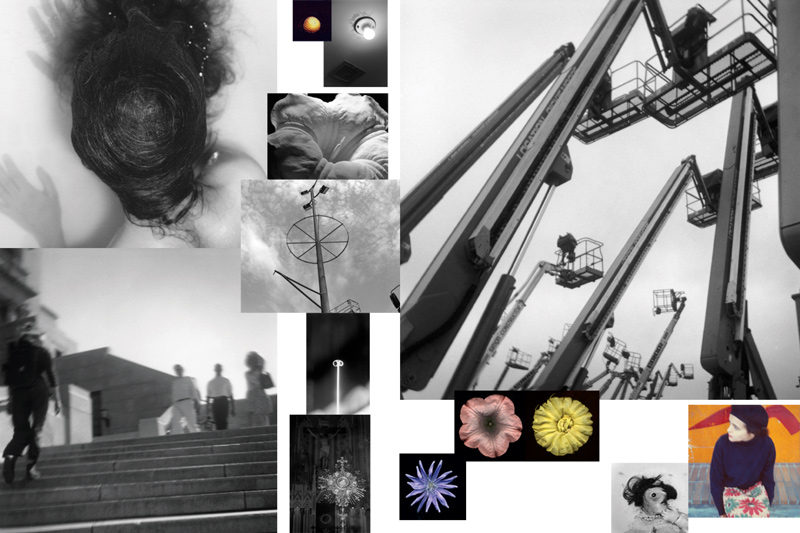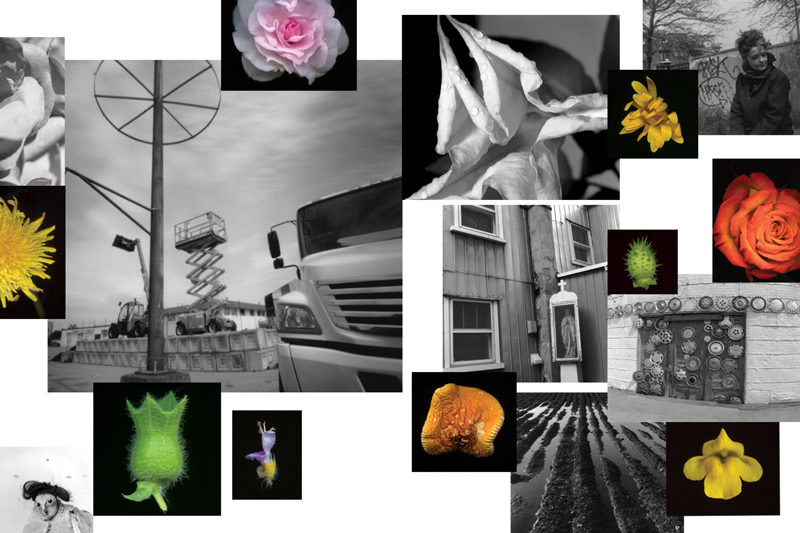[Winter 2011]
by Sylvain Campeau
Sylvain Campeau: What strikes viewers when they go to see an exhibition by Yan Giguère is the special way you have of aligning images of very different formats and distributing them on the wall. It has been referred to as a constellation. How did you come to be interested in this type of presentation ?
Yan Giguère: I had the idea of the constellation at the beginning of my career. It was in 1997, in the group exhibition at Plein Sud “Antidote (la légèreté à l’œuvre).” At the time, I was fascinated by the idea that time doesn’t necessarily unfold in a succession of moments; instead, moments may burst out simultaneously. The dispersed way that the piece Ici et là was hung refers to this sense of bursting. Then, for Chavirer in 2001, I didn’t use this presentation system. The dozen images displayed were all in the same format and hung in a line.
For my exhibition “Bienvenue,” at B-312 in 2002, I reduced the number of images presented to three. At the time, I wanted people to look more at the images than at the grouping as a whole. But for “Choisir,” in 2007, which consisted of a group of portraits of my wife (taken over a fifteen-year period), I returned to that type of dispersed hanging because in this project, time as a subject was in the foreground. I didn’t want to create a linear, biographical story, unfolding chronologically. I wanted to play with the superimposition of eras and the multiplicity of cameras used to create the photographs, and to highlight how the images referred to each other.
SC: How, concretely, is this work done ?
YG: When I’m working on the hanging, I start with my working proofs, 8″ x 10″ pictures, in a jumble on my studio walls. Then, I prune. I choose images that I reprint in certain formats, which seem to be determined by the photographs themselves. Even the question of whether to leave a border is a serious one for me. When an image is surrounded by white, that affects how it will communicate with others. There is no precise system. Sometimes the border remains, sometimes not. The constellation is organized, almost one image at a time, each one calling out to another. Then, the group calls out to another one. It’s as if concentric circles are added on. I never have a specific idea of the goal of the work – neither the images nor the formats chosen. It’s really a back-and-forth between the images and me. Even when I am taking pictures, it is quite organic. Of course, for an exhibition project, I always try to pick out a subject. The subject emerges from the mass of photographs, starting with elements that are latent in them. A dialogue is started with other images previously taken, which have been somewhat forgotten, which resurface. The corpus is constructed in a combination of the new and the old. This creates a poetic phrasing, which forms the basis of my narrative mode. When I arrive in the gallery, everything has been decided on, placed in the studio, as a function of the space I have for the exhibition.
SC: So, when there is a second exhibition of the same series, does everything have to be redone ?
YG: No, just adapted, I don’t redo the entire phrasing. The series remains essentially the same, and the presentation is quite similar.
SC: So, a series starts with a few images around which others end up being grafted ?
YG: Yes. For “Attractions,” for example, everything started with images taken in an underground parking lot with jacks, then images of Brugmansia flowers that I had taken at home, in the backyard. For several years I had been amusing myself by compiling a photographic herbarium. The idea of working on the theme of “garden” was latent.
SC: So it is really archaeological work in which you go to dig up your own images. And some images, from one series to the next, have a vague sense of family …
YG: Sometimes they were taken at the same time. That’s what happened with “Choisir” and “Attractions,” for which I selected images that were different but were taken at the same time. I wanted to start “Attractions” with this image (Marie-Claude à la pomme) – which was at the end of the “Choisir” corpus – but with a wider angle. Finally, I work with the growing group of photographs that I make. The older images are always just as likely as recent ones to take their place on the wall. For each project, I find myself mixing things up and looking through my many boxes of working proofs. It’s a continual jumble.
SC: In “Attractions,” the image of the constellation was less relevant for you.
YG: With “Attractions,” I wanted to break the mould, to avoid repetition and boredom. I wanted to go toward phrasings that could be read horizontally and vertically but less in terms of an explosion, narrative bursts – more like deploying parentheses. The combination of the horizontality and verticality of readings led me back to the constellation, but in a more organized way than in “Choisir,” in which the idea of the bulletin board dominated.
SC: You chose two titles that refer to your practice: “Choisir” [Choosing] and “Attractions.” This suggests a way of forming a relationship with your images. You propose a guide …
YG: But not the diagram ! “Attractions” does refer to my own way of forming a relationship with the images. I am attracted to certain images, certain places, intuitively. But “attraction” also refers to gravitational force and tropism – that is, how plants are drawn toward light – thus, two contrary forces, one upward, the other downward. And since the garden is a central theme in “Attractions,” it seemed completely appropriate. I like it when people enter my exhibitions as if they were going into a forest where there are a number of possible paths to follow, and each individual follows his or her own.
SC: You also said before that images come to you. You don’t go to the images, they come to you !
YG: That doesn’t mean that I’m not always on the look-out ! I have periods when I take pictures, when I can rid myself of my other obligations. But the best pretext is when I want to try a new camera I’ve found at a junk shop. For a number of years, I’ve been collecting low-end amateur cameras. I’m always curious about their peculiarities, their way of “poorly” transmitting light onto film. Surprisingly, when I come back from these excursions, extraordinary things have often happened. So, I don’t go looking for one or several specific images.
SC: But you do choose places to go.
YG: Often they are places glimpsed when I’m out during the day – either on the way between my house and my workplace, or in the backyard here, in the garden. It may happen that I go to find specific images when my corpus begins to shrink. Or I have taken photographs in a place that I found interesting and I go back to take more images from other points of view or with a different type of camera. What is a constant in my process of taking pictures is indeterminacy. I photograph, in the end, anything, and then decide on the images later. I look for something that I can’t name.
The subject emerges from the mass of photographs, starting with elements that are latent in them. A dialogue is started with other images previously taken, which have been somewhat forgotten, which resurface.
SC: You have remained faithful to analog photography, despite a short incursion into digital for “Attractions.” Your entire modus operandi is based on analog, using all sorts of cameras.
YG: Over the years – I’ve been taking photographs for twenty-five years – I have acquired a certain love for photographic materials. I make photographs because I like the medium. I like the whole “kitchen,” I like the optics, I like the mechanics, I like the chemistry. I also adore the latency, the time that stretches out, to a greater or lesser extent, between the taking of the picture and the appearance of the image. When you isolate yourself in the darkroom you’re cutting yourself off from the world, in an almost sacred place. At the same time, despite all the control that you might have over the process, there are surprises there. There is a part of the work that happens by itself, just because you’re doing something with the material. I like it that the material participates in the results. It may be simply a particular combination of developer and film or an error of exposure. It also explains why I use old cameras the parameters of which I can’t always control. It is part of the pleasure, of the unexpected. Sometimes I take the same picture with three different cameras. My range of cameras goes from the 4 x 5 chamber camera to a disposable purchased in 1994 that I’m still reloading today with black-and-white film !
SC: So, this collecting, this search for new cameras, isn’t just a whim.
YG: I don’t want to get bored, and I don’t want to bore other people either ! Experimenting with new cameras, sometimes unsophisticated ones, offers all sorts of surprises. They, not I, determine what the image taken will be. Translated by Käthe Roth
Yan Giguère has been a well-known figure in the Quebec contemporary art scene since the mid-1990s. His most recent photographic works were in solo exhibitions at Galerie Optica in 2009, Centre VU in 2008 and 2002, and Galerie B-312 in 2002. His pieces, which are in a number of collections, highlight the poetry of the everyday in series with strong narrative potential arranged on the walls of the exhibition space. He is the coordinator of the carpentry workshop at the Centre Clark. He lives and works in Montreal.
Sylvain Campeau has contributed to both Canadian and European magazines (Ciel variable, ETC, Photovision, and Papal Alpha) and has curated thirty exhibitions presented in Canada and abroad. He is the author of the essay Chambre obscure: pho- tographie et installation and of four poetry collections.





